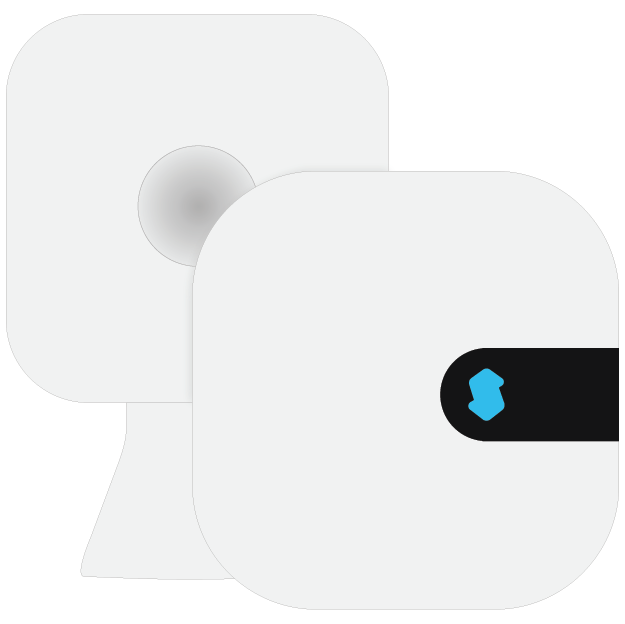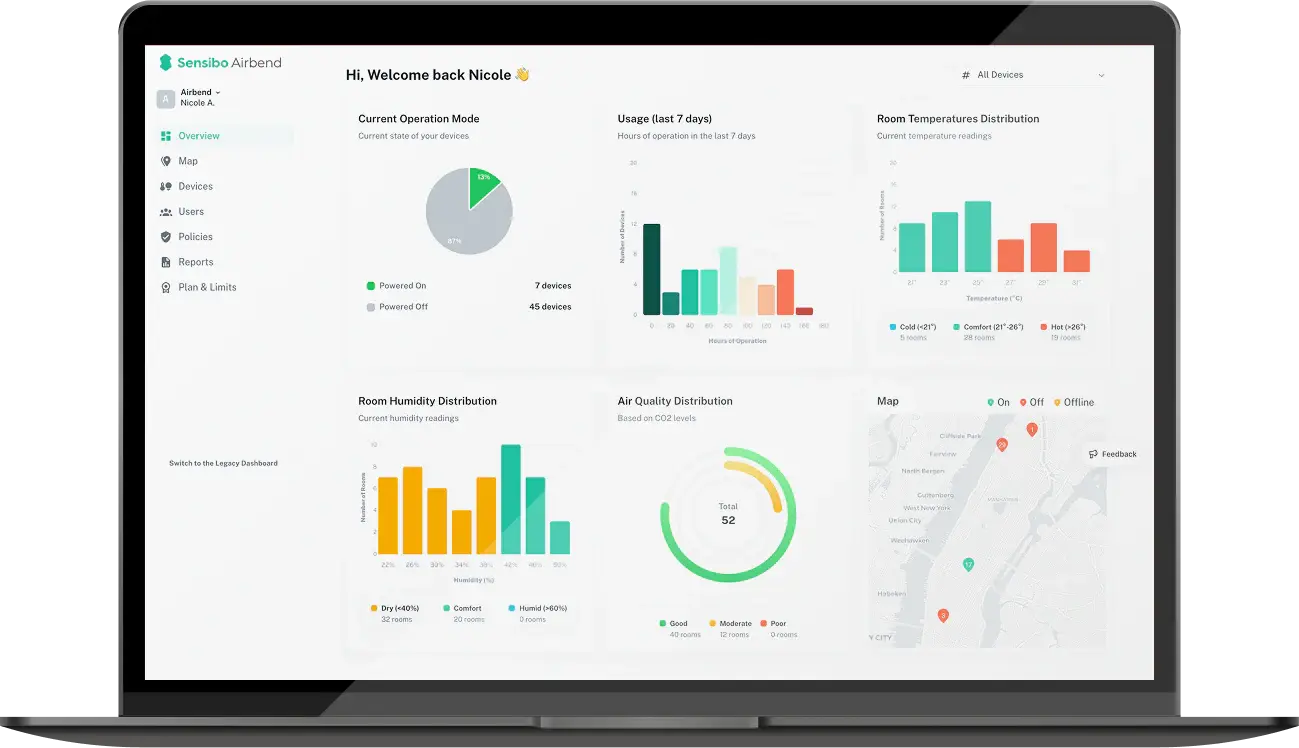Sensibo vs. Universal AC Remote: Which Is Better for Your Home?
Key Takeaways
- Budget-First Decision: Universal remotes cost $15-50 and restore basic AC control immediately. Sensibo controllers cost $119-150 but typically pay for themselves within 6-12 months through energy savings.
- Energy Impact: Universal remotes provide zero energy optimization—same consumption as your original remote. Sensibo can reduce cooling costs by 20-40% through automated scheduling and responsive adjustments.
- Setup Reality: Universal remotes often require trial-and-error with manufacturer codes, sometimes losing advanced AC functions. Sensibo learns your specific remote in under 2 minutes and preserves all original features.
- Smart Features: Universal remotes = basic button replacement. Sensibo = smartphone control, geofencing, voice commands, multi-user access, and integration with smart home systems.
- Best For Universal: Tight budgets, rental properties, unreliable WiFi, users who prefer physical remotes over smartphone apps.
- Best For Sensibo: Energy cost reduction priority, smart home integration, multiple AC units, families wanting shared control, long-term homeowners.
Your AC remote stopped working yesterday. Dead batteries? Lost between cushions? Stepped on by the dog? The reason doesn't matter now—you need cooling control back, fast.
Two paths stretch ahead: grab a $20 universal AC remote from the nearest store, or spend $119+ on a Sensibo smart controller. One gets you basic button-pushing restored. The other promises smartphone control, energy savings, and automation features that didn't exist when your AC was manufactured.
This analysis dissects both options using actual costs, real performance data, and honest trade-offs. No marketing spin, no affiliate pressure—just the facts you need to pick the right solution for your home, usage patterns, and wallet.
What Are Universal AC Remotes
A universal AC remote serves as a replacement device designed to control air conditioning units from multiple manufacturers. These remotes come in two primary forms: traditional handheld devices with physical buttons and smartphone applications that leverage your phone's infrared capabilities.
Physical universal remotes typically support dozens of AC brands through pre-programmed manufacturer codes. Popular options include models from GE, RCA, and various third-party manufacturers, with prices ranging from $15 to $50. Meanwhile, smartphone apps like "Universal AC Remote Control" and "AC Remote" offer similar functionality through your device's built-in IR blaster, assuming your phone includes this hardware.
The appeal lies in simplicity: one device potentially controls your Daikin, LG, Samsung, or Panasonic unit without brand-specific shopping. However, compatibility depends entirely on whether your specific AC model's infrared protocol exists in the remote's database.
 How Universal AC Remotes Work
How Universal AC Remotes Work
Universal remotes operate through infrared signal transmission, mimicking the exact commands your original remote control for the air conditioner would send. The setup process involves either automatic code searching or manual entry of manufacturer-specific codes.
For automatic setup, you point the universal remote at your AC unit, press and hold a "Set" button for several seconds, and wait for the remote to cycle through stored codes until your unit responds. Manual setup requires finding your AC model's specific code from included documentation, then programming this code into the remote.
Code Programming Steps:
- Locate your AC brand and model code
- Press "Set" button and enter the code sequence
- Test basic functions like power, temperature, and mode
- Repeat with different codes if some functions don't work
The main limitation becomes apparent here: some advanced features like specialized fan modes, energy-saving settings, or timer functions might not transfer properly, even when basic controls work fine.
Cost Analysis
Universal remotes win on upfront costs. Physical remotes range from $15 for basic models to $50 for versions supporting more brands and functions. Smartphone apps are typically free downloads, though they require phones with IR blaster hardware - a feature increasingly rare in newer devices.
However, hidden costs emerge over time. If your first code attempt doesn't enable all functions, you might need to purchase additional remotes or accept reduced functionality. Some apps include subscription fees for premium features or charge for extended brand databases. Most significantly, universal remotes offer zero energy optimization, potentially costing more in utility bills than their purchase price saves.
Sensibo Smart Controllers Overview
The Sensibo Product Line
Sensibo offers three distinct smart controllers, each targeting different user needs and budgets. Sensibo Sky represents the entry point at approximately $119, providing core smart functionality without premium features. This model converts any old air conditioner into a connected device capable of smartphone control, scheduling, and basic automation.
The mid-tier Sensibo Air adds Apple HomeKit compatibility, an updated design, and improved wireless connectivity through both WiFi and Bluetooth Low Energy. At around $135, it appeals to users already invested in Apple's ecosystem or those wanting more reliable connectivity.
Sensibo Air Pro tops the lineup with built-in air quality monitoring alongside all smart control features. Priced around $135-150, it tracks CO2 levels, total volatile organic compounds (TVOC), and PM2.5 particles, making it suitable for health-conscious users or those dealing with air quality concerns.
 Core Smart Features
Core Smart Features
All Sensibo models provide comprehensive smart AC control that extends far beyond simple replacement functionality. The smartphone app enables remote control for air conditioner operation from anywhere with internet access, letting you pre-cool your home during commutes or ensure systems shut off after departing.
Advanced Automation Options:
- 7-day scheduling: Different temperatures for weekdays vs. weekends
- Geofencing: Automatic on/off based on phone location
- Climate React: Responds to actual room conditions rather than fixed schedules
- Voice control: Works with Alexa, Google Assistant, and Siri
- Smart home integration: Connects with other home automation systems
The built-in temperature and humidity sensors enable responsive automation that traditional remotes simply cannot match. Instead of running your AC at fixed settings, the system adjusts based on actual conditions, occupancy patterns, and weather forecasts.
Installation and Compatibility
Sensibo setup takes approximately one minute according to the company's testing. You scan a QR code on the device, connect it to your 2.4GHz WiFi network, then point your original AC remote at the Sensibo and press the power button. The device learns your unit's infrared commands and immediately enables smartphone control.
This approach works with virtually any air conditioner that uses infrared remote control, including mini-split systems, window units, portable ACs, and central air with wireless remotes. The compatibility extends to heat pumps and covers most major brands without requiring specific model codes or complex programming.
The WiFi requirement does create a dependency that universal remotes avoid, but it also enables the advanced features that justify the higher price point.
 Feature-by-Feature Comparison
Feature-by-Feature Comparison
Basic Control Functions
Both solutions handle fundamental AC operations, but with different levels of sophistication. Universal remotes replicate your original remote's button layout, providing direct access to temperature adjustment, mode switching (cool, heat, fan, auto), fan speed control, and timer functions.
Universal Remote Capabilities:
- Temperature control in 1-degree increments
- Mode switching between cooling, heating, and fan
- Fan speed adjustment (low, medium, high)
- Basic timer functions (typically 1-24 hours)
- Some advanced modes if properly coded
Sensibo controllers offer identical basic functions through their smartphone interface, plus additional precision. You can set temperatures to half-degree increments, access all original remote functions, and monitor current conditions through built-in sensors.
The key difference emerges in reliability and user experience. Universal remotes require line-of-sight to your AC unit and can lose programming if batteries die. Sensibo operates through WiFi, working from anywhere in your home or beyond, with settings stored in the cloud.
Advanced Features
Here's where the solutions diverge dramatically. Universal remotes provide static control - they send commands when you press buttons, nothing more. Smart controllers like Sensibo convert your old air conditioner into an automated system capable of intelligent decision-making.
Sensibo Advanced Features:
- Intelligent scheduling: Different settings for each day of the week
- Geofencing automation: AC turns on when you're 10 minutes from home
- Weather integration: Adjusts cooling based on outdoor temperature forecasts
- Usage analytics: Track energy consumption patterns and optimization suggestions
- Multi-user access: Family members can control the same unit through individual apps
The reducing energy consumption capabilities alone often justify the price difference. Sensibo's Climate React feature monitors room conditions continuously, adjusting temperature and fan settings to maintain comfort while minimizing energy waste. This responsive automation can reduce cooling costs by 20-40% compared to manual operation.
Universal remotes offer none of these optimizations. They're essentially digital versions of your original remote, with the same energy efficiency - or lack thereof.
User Experience
Daily interaction patterns reveal practical differences between solutions. Universal remotes feel familiar because they mirror traditional remote layouts, but this familiarity comes with traditional limitations. You must physically locate the remote, ensure it has battery power, and manually adjust settings as conditions change.
Universal Remote User Experience:
- Familiar button layout and operation
- No learning curve for basic functions
- Works without WiFi or internet connectivity
- Requires line-of-sight positioning
- Manual programming for multiple units
Sensibo's smartphone interface requires brief adaptation but offers superior convenience once learned. The app displays current temperature and humidity readings, shows energy usage trends, and enables control without searching for physical remotes. Multiple family members can install the app and access the same AC unit without coordination.
Setup complexity varies significantly. Universal remotes often require trial-and-error with multiple manufacturer codes until all functions work properly. Some users never achieve full functionality, settling for basic temperature and mode control while losing access to specialized features.
Sensibo setup consistently takes under two minutes across different AC brands. Point your original remote at the device, press power, and the learning process completes automatically. This reliability stems from Sensibo's approach of learning your specific remote's signals rather than relying on generic manufacturer codes.
Real-World Performance Analysis
 Reliability and Connectivity
Reliability and Connectivity
Connection stability differs fundamentally between solutions. Universal remotes use infrared signals that require direct line-of-sight between remote and AC unit. Obstacles like furniture, curtains, or simply pointing the remote at the wrong angle can prevent commands from registering. This limitation becomes particularly frustrating when controlling wall-mounted or ceiling units from certain room positions.
Smart controllers like Sensibo operate through WiFi networks, eliminating line-of-sight requirements but introducing different dependency factors. Your internet connection quality, router position, and network congestion can affect responsiveness. However, Sensibo devices connect to 2.4GHz networks specifically for better range and wall penetration compared to 5GHz bands.
Performance Comparison Data:
- Universal remote response time: Instant (when properly aimed)
- Sensibo response time: 1-3 seconds via app
- Universal remote range: 15-20 feet with clear line-of-sight
- Sensibo range: Anywhere with internet access
Real-world testing shows universal remotes work reliably for direct replacement scenarios but struggle with convenience features like controlling multiple units or operation from other rooms. Sensibo provides consistent control from anywhere but requires stable WiFi for optimal performance.
Energy Savings Potential
This comparison reveals the most significant long-term difference between solutions. Universal remotes enable the same energy consumption patterns as your original remote - entirely dependent on manual adjustment and user behavior. If you forget to raise the temperature when leaving home or fail to adjust settings for overnight comfort, energy waste continues unchanged.
Sensibo's reducing energy consumption features operate automatically once configured. Geofencing ensures your AC turns off when the last family member leaves and resumes cooling before anyone returns. Smart scheduling reduces overnight cooling when blankets provide additional comfort, then ensures rooms reach comfortable temperatures before morning routines begin.
Energy Savings Analysis:
- Universal remote energy impact: 0% improvement over manual operation
- Sensibo reported savings: 20-40% reduction in cooling costs
- Payback period for Sensibo: 6-12 months in most climates
- Annual savings potential: $200-600 depending on usage and local electricity rates
Climate React automation provides the most substantial savings by responding to actual conditions rather than fixed schedules. When outdoor temperatures drop unexpectedly, the system reduces cooling automatically. When humidity levels rise, it adjusts fan speeds for comfort without excessive temperature reduction.
Compatibility Challenges
Both solutions face compatibility limitations, but with different characteristics. Universal remotes work with most AC brands but may not support every function of your specific model. Advanced features like turbo modes, energy-saving settings, or specialized timer functions often get lost in translation, even when basic controls work perfectly.
Common Universal Remote Limitations:
- Incomplete function support (missing 10-30% of original features)
- No access to manufacturer-specific modes
- Limited or no timer programming options
- Inability to control multiple zones independently
Sensibo controllers learn your specific remote's complete command set, preserving access to all original functions through the smartphone interface. Compatibility issues typically involve network connectivity rather than AC control capabilities. The main limitation involves AC units that use non-infrared communication protocols, though these represent less than 5% of residential installations.
Sensibo Compatibility Requirements:
- AC unit must use infrared remote control
- 2.4GHz WiFi network required
- Smartphone with iOS or Android operating system
- Internet connection for remote access and updates
Pros and Cons Summary
Universal AC Remote Advantages
Budget-conscious consumers find immediate appeal in universal remotes' low upfront costs. At $15-50, they provide basic AC control restoration without significant financial commitment. This affordability makes them attractive for rental properties, vacation homes, or situations where long-term investment doesn't make sense.
The offline operation capability offers reliability benefits in areas with unreliable internet service. Universal remotes work during WiFi outages, network maintenance, or when traveling to locations without internet access. For users who prefer simple, straightforward solutions without smartphone dependencies, traditional remotes maintain familiar operation patterns.

Key Universal Remote Benefits:
- Low initial cost ($15-50)
- No WiFi or internet dependency
- Familiar operation for all users
- Works during power/internet outages
- No ongoing subscription or service fees
Universal AC Remote Disadvantages
The limitations become apparent during daily use. Manual operation means no automation, no energy optimization, and no convenience features beyond basic temperature control. Users must remember to adjust settings manually for different times of day, weather conditions, or occupancy changes.
Significant Universal Remote Drawbacks:
- Zero energy savings compared to original remote
- No scheduling, automation, or smart features
- Limited function support for many AC models
- Requires line-of-sight operation
- No multi-user access or smartphone integration
- Complex setup process with inconsistent results
The energy cost implications often exceed the initial savings within the first year. Without automated optimization, many users continue wasteful cooling patterns that smart controllers would eliminate automatically.
Sensibo Smart Controllers Trade-offs
Higher upfront investment represents the primary barrier for Sensibo adoption. At $119-150, the cost requires justification through long-term benefits rather than immediate savings. Users uncomfortable with smartphone-dependent systems may find the interface intimidating initially.
WiFi dependency creates potential reliability concerns in homes with unstable internet connections. During network outages, you lose remote access capabilities, though the AC continues operating at its last programmed settings.
Sensibo Considerations:
- Higher initial cost ($119-150)
- Requires stable WiFi network
- Learning curve for smartphone interface
- Internet dependency for remote access
- More complex technology vs. simple remote replacement
However, the energy savings typically recover the initial investment within 6-12 months, while convenience and automation features provide ongoing value that traditional remotes cannot match.
Decision Framework: Which Solution Fits Your Needs?
Choose Universal AC Remote If:
Budget constraints make immediate cost the primary decision factor. If you need basic AC control restoration for under $50 and don't require any advanced features, universal remotes provide adequate functionality. This approach works particularly well for rarely-used spaces, rental properties, or temporary solutions.
Limited technical comfort levels favor traditional remotes. Users who prefer physical buttons over smartphone interfaces, or those concerned about WiFi security and privacy, find universal remotes less intimidating. The offline operation capability suits homes with unreliable internet service or users who travel frequently to areas without connectivity.
Universal Remote Best Scenarios:
- Extremely tight budget ($50 available)
- Unreliable or no WiFi network
- Rental property or temporary housing
- Users uncomfortable with smartphone technology
- Backup remote for infrequent use areas
Choose Sensibo If:
Energy savings priority drives the decision-making process. If reducing monthly cooling costs matters more than upfront investment, Sensibo's automation features typically pay for themselves within the first year while providing ongoing convenience benefits.
Smart home integration enhances value for users already invested in connected home ecosystems. Sensibo works with Alexa, Google Assistant, Apple HomeKit, and various home automation platforms, enabling coordinated control of multiple systems.
Sensibo Optimal Scenarios:
- Energy cost reduction priority
- Smart home ecosystem integration desired
- Multiple AC units requiring management
- Family members wanting individual app access
- Long-term property ownership
- Reliable WiFi network available
Sensibo's universal AC remote offers smart features for energy savings, while universal remotes offer basic control. Sensibo's investment in automation and convenience offers superior value over time.
FAQ
Can I use a universal AC remote with any air conditioner brand?
Most universal AC remote devices support major brands like Samsung, LG, Daikin, and Panasonic through pre-programmed codes. However, some advanced features like turbo modes or specialized timers might not work even when basic controls function properly.
How much money can Sensibo actually save on energy bills?
We can claim 20-40% reduction in energy consumption, translating to $200-600 annual savings depending on usage and electricity rates. Savings come from automated scheduling and geofencing that prevent common energy waste.
Do I need technical skills to set up either option?
Universal AC remote setup involves entering manufacturer codes or auto-searching, taking 5-30 minutes with possible trial-and-error. Sensibo takes under 2 minutes: scan QR code, connect to WiFi, point original remote at device, press power.
What happens if my WiFi goes down with Sensibo?
Your AC continues operating at last programmed settings but you lose smartphone control until WiFi returns. Universal remotes work completely offline, making them better for areas with unreliable internet.
Will Sensibo work with my old air conditioner from the 1990s?
Any old air conditioner with an infrared remote control works with Sensibo, regardless of age. Only newer units using Bluetooth or WiFi (less than 5% of installations) won't work.





































.jpg?height=200&name=photo_2024-11-08_11-56-41%20(1).jpg)
.jpg?height=200&name=photo_2024-04-02_19-30-49%20(1).jpg)